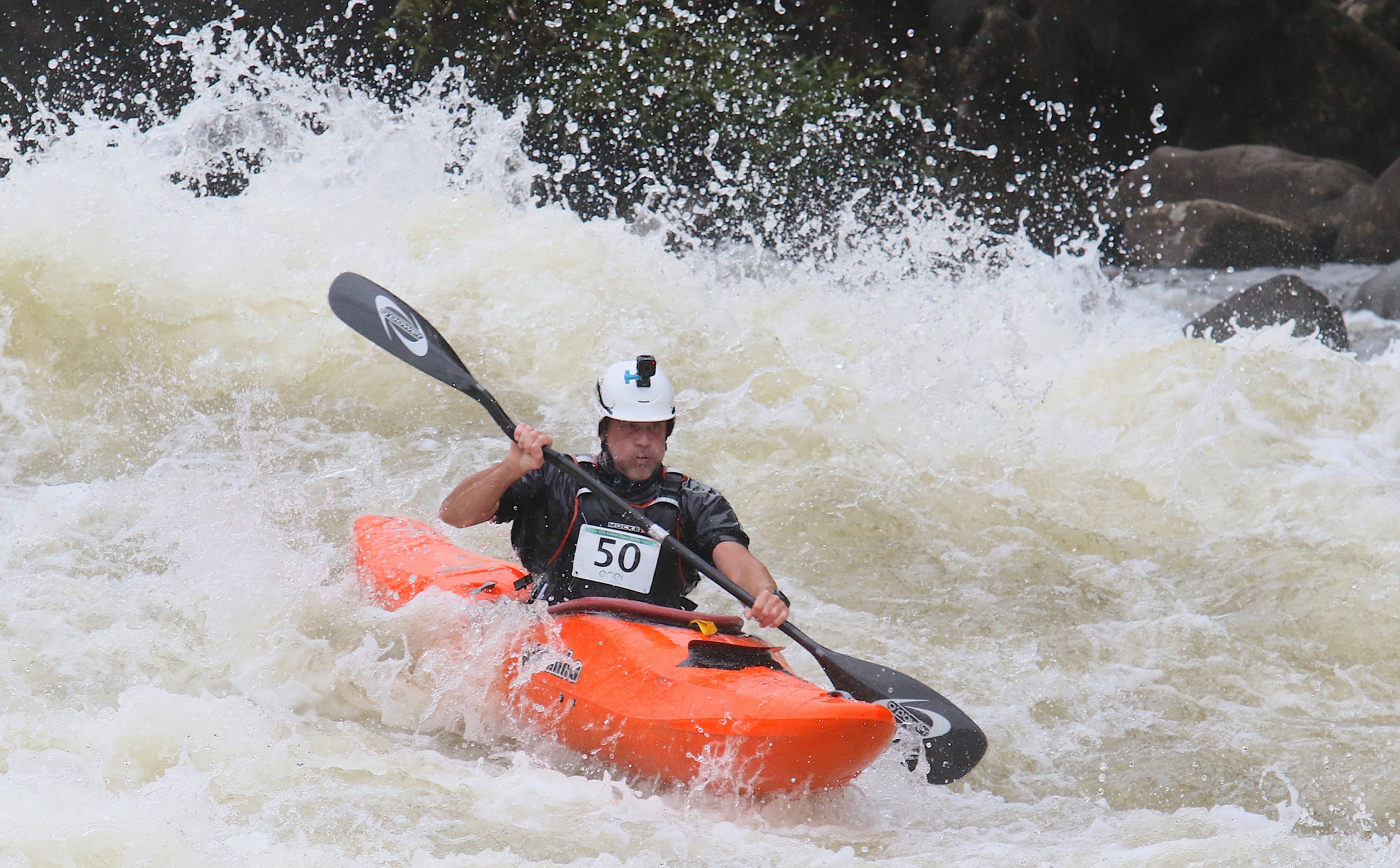
Photo by Leisure Sports Photography / Whitewater Photography
27
Sep

Photo by Leisure Sports Photography / Whitewater Photography
25
Sep
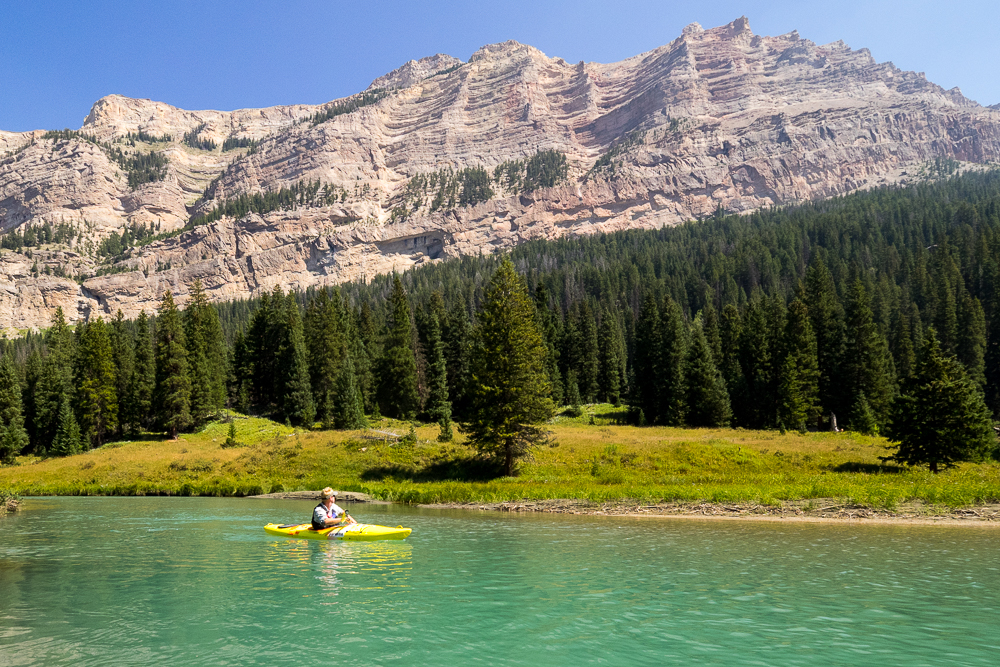
Upper Green River, WY
Like plenty of stories, this one begins with winning a launch date for the Grand Canyon. Where this story maybe takes a sharp turn was finding a kayak that I could cram a bunch of books inside…
Several years ago, I was sitting with friends on a rental cabin porch in the Appalachians of Tennessee during one of our annual kayaking trips. I started boating in California, and I’d been suggesting we head out west for some expedition trips on big desert rivers.
I was one of the last applicants to join the old Grand Canyon waiting list, which meant I’d carried over extra chances into the new lottery system. I’d failed a few times to win a peak-season trip, but now I suggested we instead use my assisted odds to pick an exact date for a winter trip that we could all agree on. Several of us were teachers, so if we pinpointed the dates just right, we could slip a long trip into our Christmas breaks.
The next February, I entered the lottery and we won a launch date for the second day of winter about 20 months ahead. Then I went one step further, suggesting we do what I now call a fresh-eyes descent, meaning none of us in the group had ever boated the river before. For a number of reasons, I didn’t want to invite any crusty all-knowing canyon veterans along who would lead us down. I’d met too many already, with their do-this, don’t-do-that, this-is-best, that’s-overrated attitudes. Instead, for our first Grand Canyon trip, we’d get our own exploratory expedition—sort of like John Wesley Powell.
But soon I had a major realization. Like Powell, I’d said. Here was a major historical figure I thought of as a hero of mine. We California raft guides and kayakers often talked about Powell with the reverence usually reserved for saints or whoever started In-N-Out Burger. But I knew almost nothing beyond the basics. Powell’s team boated the Grand Canyon first, in 1869, and the crews rowed backward—a few details all reported on a postage stamp!
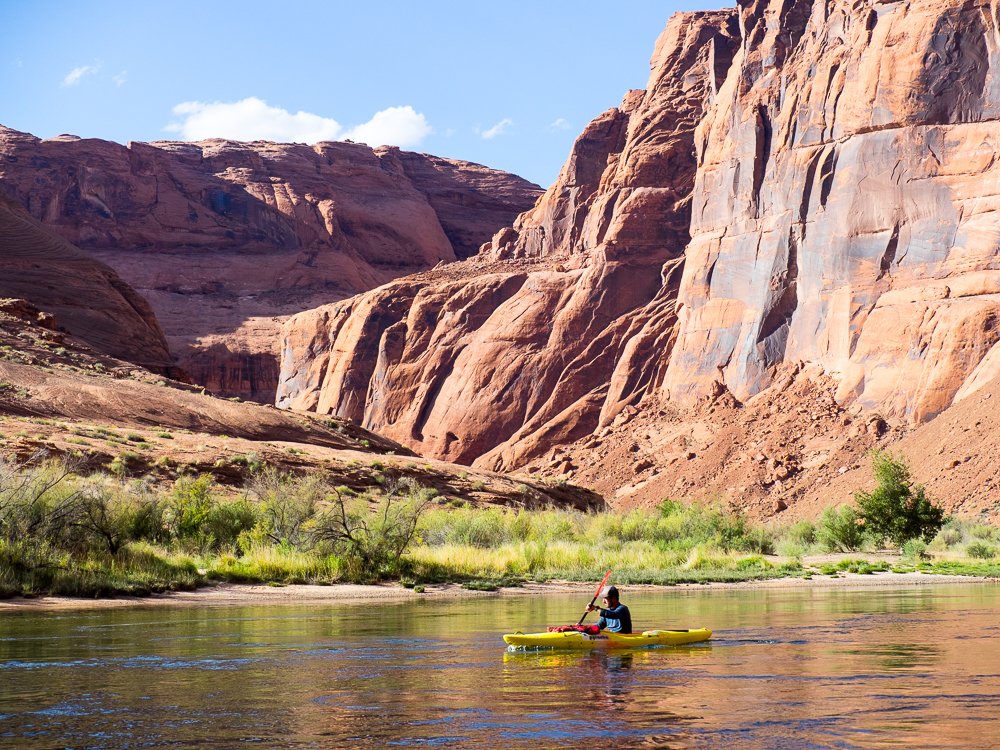
Horseshoe Bend, Glen Canyon
So, I started reading. Book after book. Journals, histories, opinions, trip reports. Powell, Dellenbaugh, Stegner, Stanton, Ghiglieri, Dolnick, Zwinger, Belknap, Martin, Fedarko. My head was swimming! There were two expeditions? Powell embellished or maybe lied? The three crewmen who left may have been killed by Mormons who blamed local Shivwits tribesmen? I decided a single Grand trip would not suffice. Like many paddlers, I became infatuated with one of the greatest adventure stories in U.S. history. I wanted to follow Powell’s entire expedition route, which grew in reverence with every new fact I learned. Each controversy only deepened the “fresh eyes” mystery. I wanted to be a Powell Route Pilgrim.
So that’s what I did, but not as I first had hoped. I briefly considered taking a semester off from adjunct teaching and doing the entire route in one go. But I dropped that notion due to financial realities. Then I tried to go in segments, in order, but I couldn’t get the permits to line up with my time off. Instead, I settled on doing the segments, over several years, in whatever order was possible. And I did them all as fresh eyes descents, using a mix of watercraft, including kayak, raft, paddleboard, and packraft.
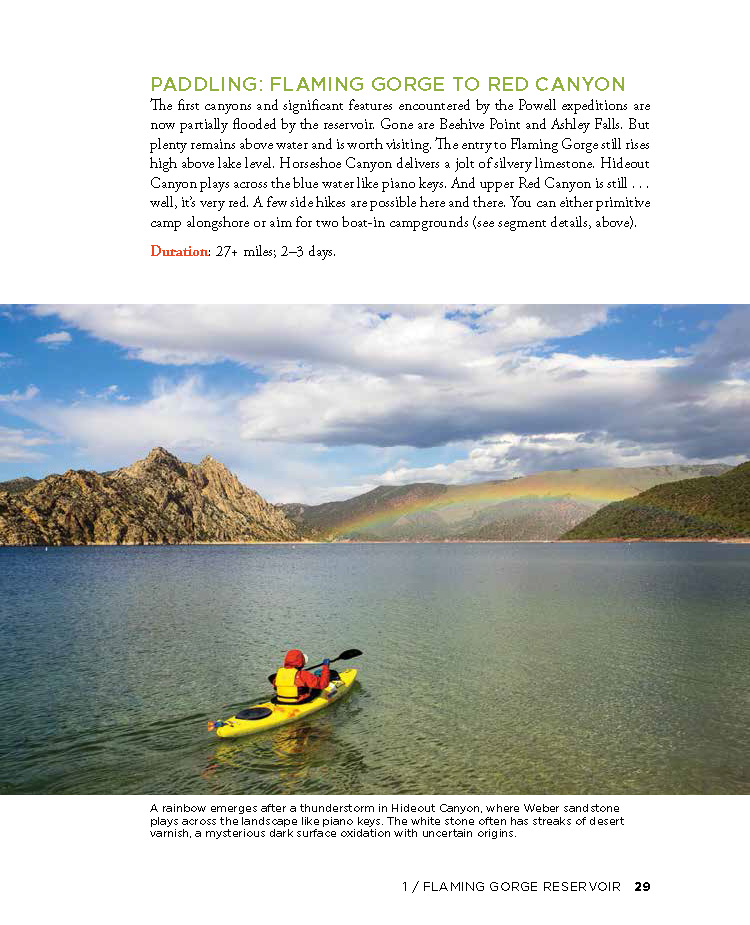
One day, I found myself only a few months away from doing the first segment and still unsure of what boats to use. With a friend, I’d start from Green River, Wyoming with ten miles of river followed by 85 across Flaming Gorge Reservoir. After the dam was 20 miles of class II whitewater and then even more flatwater. The following section through class III Lodore Canyon would have to wait until I won their lottery. Further down the route, I’d find more class II-III in Deso, more flatwater in the Uinta Basin and Canyonlands, some class III-IV whitewater in Cataract, more flatwater on Lake Powell, plenty of class III-IV whitewater in the Grand Canyon, and—did I mention the flatwater?!—a 50-mile finish on Lake Mead.
Then, my buddy, a Pyranha team paddler, mentioned a new boat option to me. The recently released Pyranha Fusion was a hybrid kayak with a storage hatch and plenty of space. I could drop the skeg and muscle-motor across the long flatwater sections. I could snap on a skirt and buckle my helmet for fun whitewater with a fast longboat profile. So, we picked up a pair of them and never looked back.
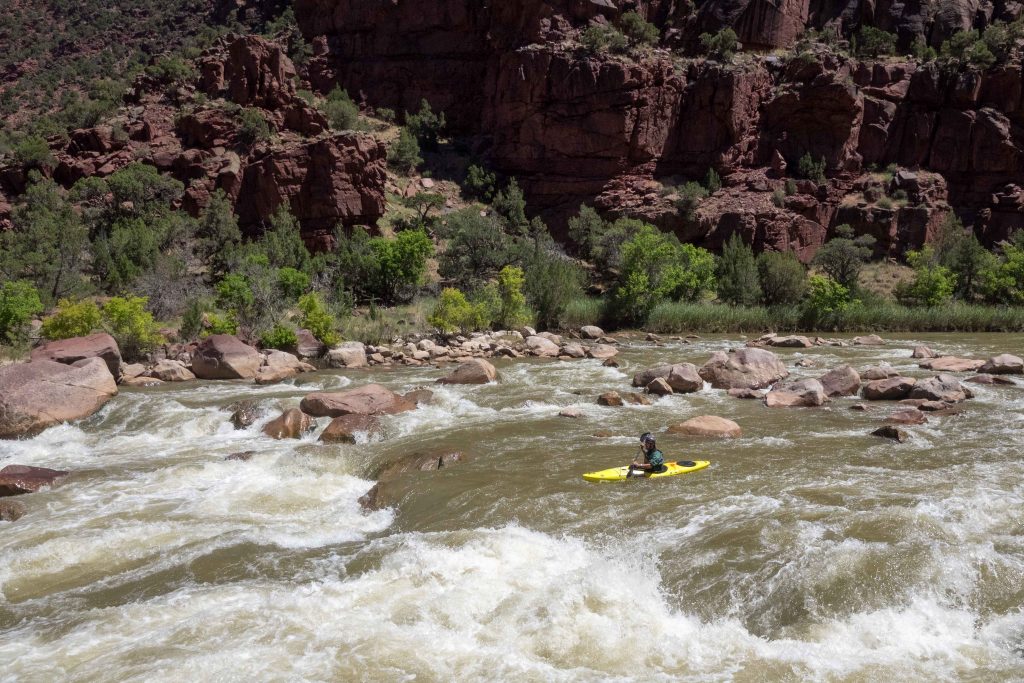
Since that time, the boats have been with me and my friends for the entire project that became my recently published book, Paddling the John Wesley Powell Route. Sometimes we did kayak self-support while other times we had them along on larger trips. Sometimes I paddled them and sometimes my friends took them down, as we rotated on the oars of a raft that became a crucial support craft. (I mean I love kayaking, but I also like a cooler with fresh food and cold beer on a multi-week trip in the desert, okay.) The Fusions have touched water in every segment of the 1600-mile route, plus gone with me down many favorite runs, both flatwater and whitewater across a dozen states and counting. We even took them to our annual Appalachian weekend, running them on favorites like the Ocoee and Chattooga.
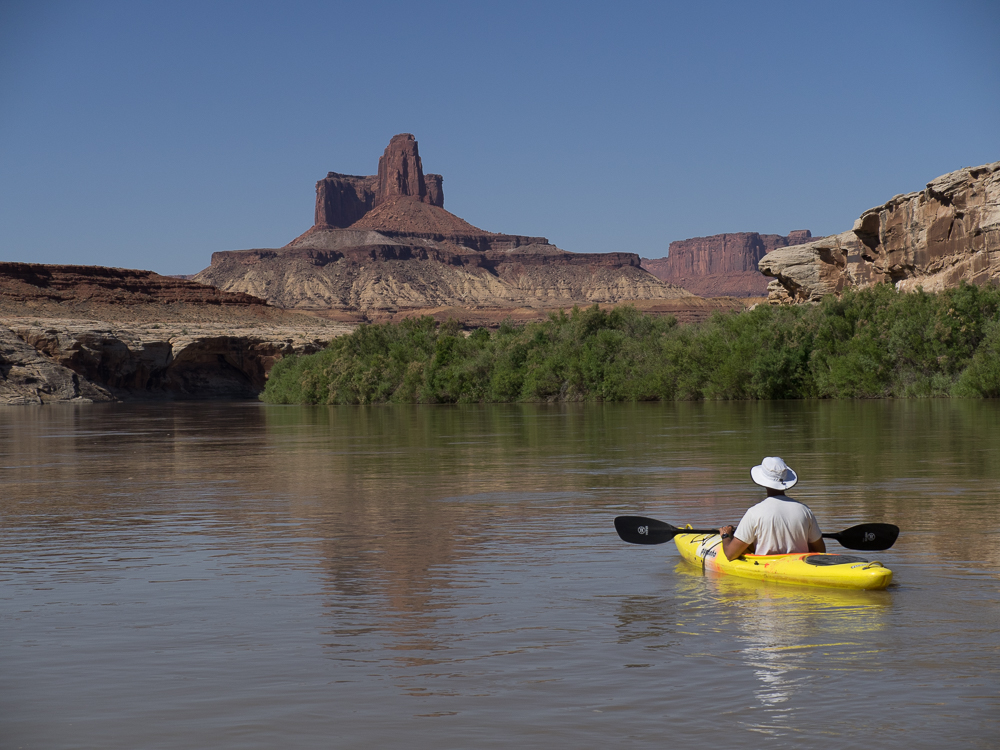
Butte of the cross, Tower Park
After nearly five years running a medium Fusion, I am happy to report that if you’re looking for a hybrid boat for kayak touring that can handle both flatwater and whitewater (a boat that has space for your history books and some campsite beers), the Fusion is a perfect choice. And if you’re going down the Powell route—a place with rugged canyons full of fascinating history, plus the occasional big-water rapid tucked between long sections of flatwater through unbelievable desert scenery—you’re going to need a boat that can hold books AND beer.
I hope to see you out there!
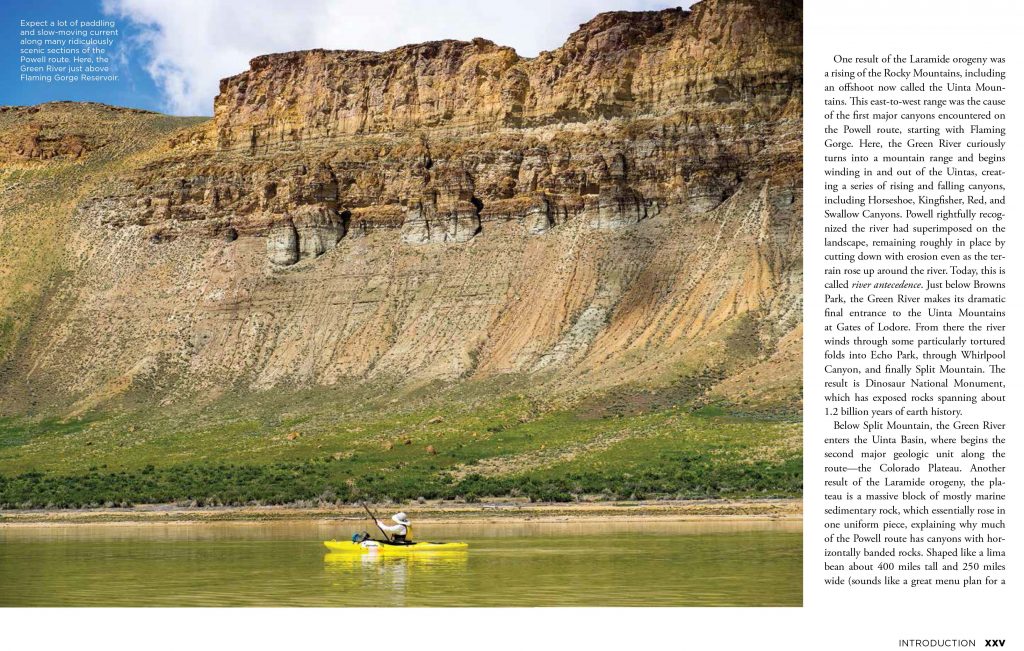
Mike Bezemek is the author and photographer of books, blogs, and articles for a variety of publications, including Paddling the John Wesley Powell Route and Paddling the Ozarks for Falcon. He paddles the Burn, Machno, Jed, and Fusion.
22
Sep
Quick tutorial I made of how I personally take my kayak from factory fresh to river ready in under 30 minutes!
Enjoy you new kayak, see you on the water!
Bren Orton
31
Aug
This summer was full of traveling to amazing places but with one end goal in mind. The Stikine. Whitewater of the southeast where I grew up paddling is of a different kind than the Stikine. All summer I pushed myself to focus on paddling big volume rivers unlike the kind found in NC to hopefully prepare myself. After spending two weeks at the North Fork of the Payyette I began to feel at ease about paddling challenging big water.
After that we went to Squamish for some awesome mountain biking (great cardio) and so I could paddle as much as possible leading up to Stikine season. Tad Dennis from NC also, former US slalom team member, former US freestyle team member and former 2nd place finisher at The North Fork Championship was also in town planning to head north for the Stikine. We paddled the Callaghan several times together and decided to race as a team. The week leading up to the race I tried my best to learn from Tad and pay attention to how he was preparing for the race. Knowing I would need every ounce of energy to keep up with him. We ended up 2nd out of 30 teams so I guess we did something right. All with the Stikine sitting heavily on my mind, knowing any day it could start dropping to the prime levels. During our time in Squamish we paddled Fear Canyon. It was a good step to prepare for the Stikine. Tad and I developed a plan to leave Squamish in his giant red truck and leave my girlfriend Heather and his wife Lisa at a quiet campground outside Whistler. Tad got in touch with Evan Moore and Alec Voorhees who were headed to the Stikine also. We had a crew! The level was still high (around 500 cms) so we waited until a few days after Evan and Alec to head North. After a scinic 20 hour drive we arrived at the putin for the Stikine.
Crossing the metal bridge was monumental. “We made it” “ I never thought I’d actually be doing this” “what the hell are we doing” were just a few thoughts that crossed my mind. Evan and Alec were on a one day lap with Aniol and Benny so we kept driving another 3 hours to meet them at the takeout. I bathed in the river and we cooked food. As soon as we finished eating the boys rolled up. There faces tired and sunburned. “I’ll probably look similar in a few days” I thought. We loaded up and went to the putin where we spent the night with plans to put on the following day for a two day mission. The next morning we arose to a perfect water level (420 cms). We packed our gear and pushed off onto the river.
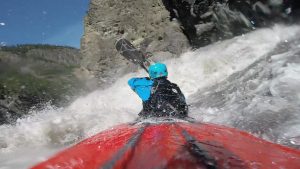
My large 9r sat slightly lower in the water due to being loaded with probably too much stuff. It paddled differently, better almost. Our crew now included Benny Marr who knows the Stikine like the back of his hand. After paddling in for a little more than an hour we adjusted our gear and dropped into “entrance”. That whole day felt like a dream. I paid close attention to the person I was following, never letting my guard down or becoming complacent. The Stikine demands your attention at all times. Even the flatwater wasn’t flatwater. It was all boils! We battled the whitewater and the boils for most of the afternoon. The canyon walls grew to 1000 feet tall with mountain goats spread along the rugged canyon. The boys fired up site zed. I was the only one that portaged. Tad got the first C1 descent of site zed which was amazing to watch. As I portaged I regretted not running it because it looked better after watching 4 people run it and I could see the rapid better from the portage. It wasn’t long after that and we were at Wolf tracks camp (30 miles in). The best campsite I’ve ever seen. It included a sandy beach, a surf wave, an overhang to sleep beneath and a creek to drink from! I slept horribly due to the mosquitos straight from hell. The weather was warm but my sleeping bag was also warm. This created a battle between getting probed by mosquitos or sweating my ass off in the Dutch oven that was my sleeping bag. I woke up early and made coffee. We all gathered our things and put on our gear at the beach. We moved downstream at a considerably fast pace. Evan and Benny would say “right to left fight the boils” or “left to right fight the boils”. We entered the last canyon that includes Scissors, the Hole that ate Chicago, V drive and Tanzilla slot. After that the river mellows to class 3 for 18 miles until the takeout at Telegraph creek.
Clean lines for everyone throughout the whole canyon made for a successful and fast lap. When we reached the takeout the locals offered us two massive salmon. We bagged the salmon and headed to the putin for another lap. We devised a plan for Evan and Tad to take the vehicles back to the takeout and hitch a ride up for another 2 day mission. Alec and I waited with the gear at the putin all day. Benny and Aniol showed up and put on the river. They were on their own program. The boys never showed up and a little before dark Alec and I found the keys to Benny’s truck and Alec went to locate them. After nearly running out of gas and having to siifen gas from Aniols car in Dease lake, Alec returned without Tad and Evan. He was unable to locate them but found internet and realized they had been in a car accident but were all good. They got a hotel room and thumbed more the next morning. The guys showed up the next morning nearly 24hrs after they left to set shuttle. We didn’t have enough food for a two day so we put on for a one day trip down the canyon. After 7 hours, including running site zed, we arrived at the takeout, had a beer and went back to the top to put on for one final two day lap.
All four of us ran Site Zed. Blue Angeling the largest rapid on the river was the pinnical of my trip. We camped at wolf tracks again. The next day we routed the last gorge and had a relaxing last day on the run out. We went to Dease lake for food and beer to celebrate three successful laps on one of the most difficult sections of whitewater in the world. Then, the next morning we made the 20 hour trek back to Squamish. What an adventure!
03
Jul
The Pyranha 12R met another milestone this week when plastic prototypes hit the river in the UK and USA on a variety of whitewater; testing like this gives us a chance to try ideas that may or may not make it into the final version, and we anticipate some things will bleed over into other designs earmarked for future development. Here’s what we found:
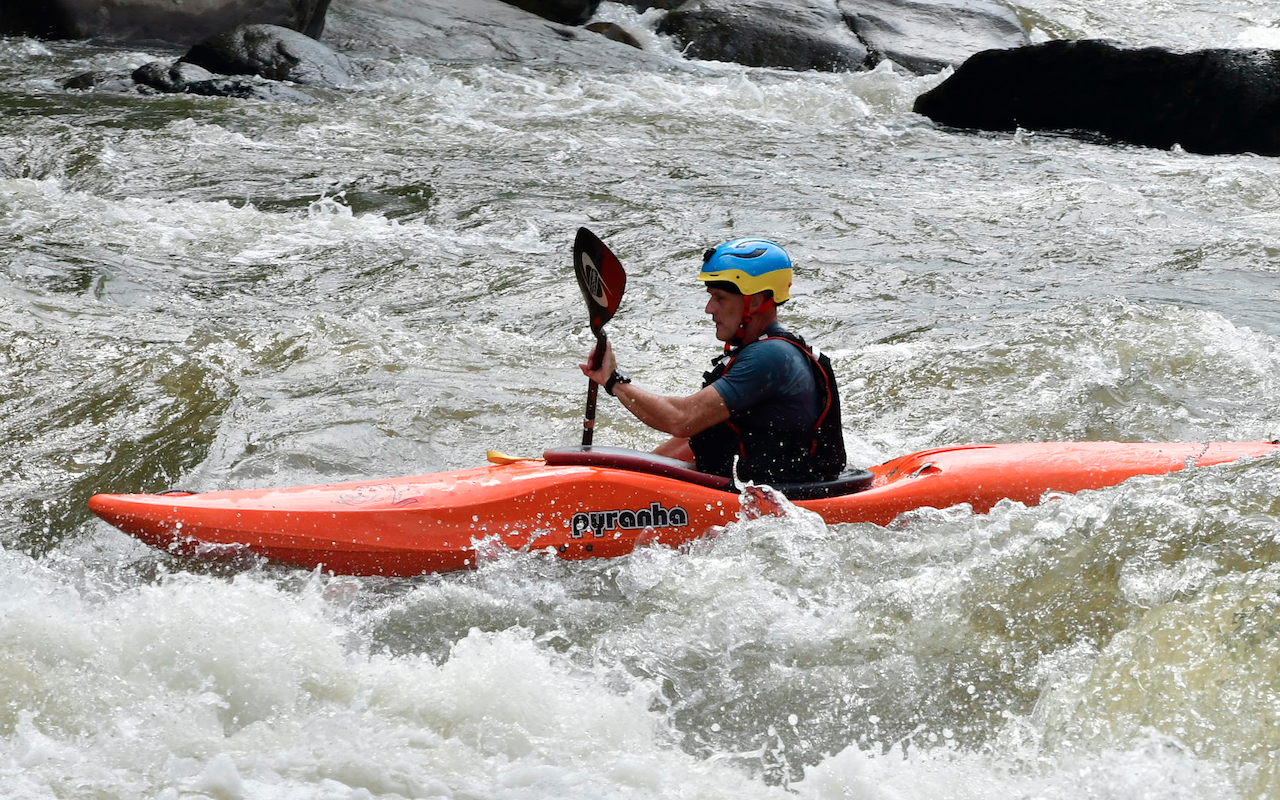
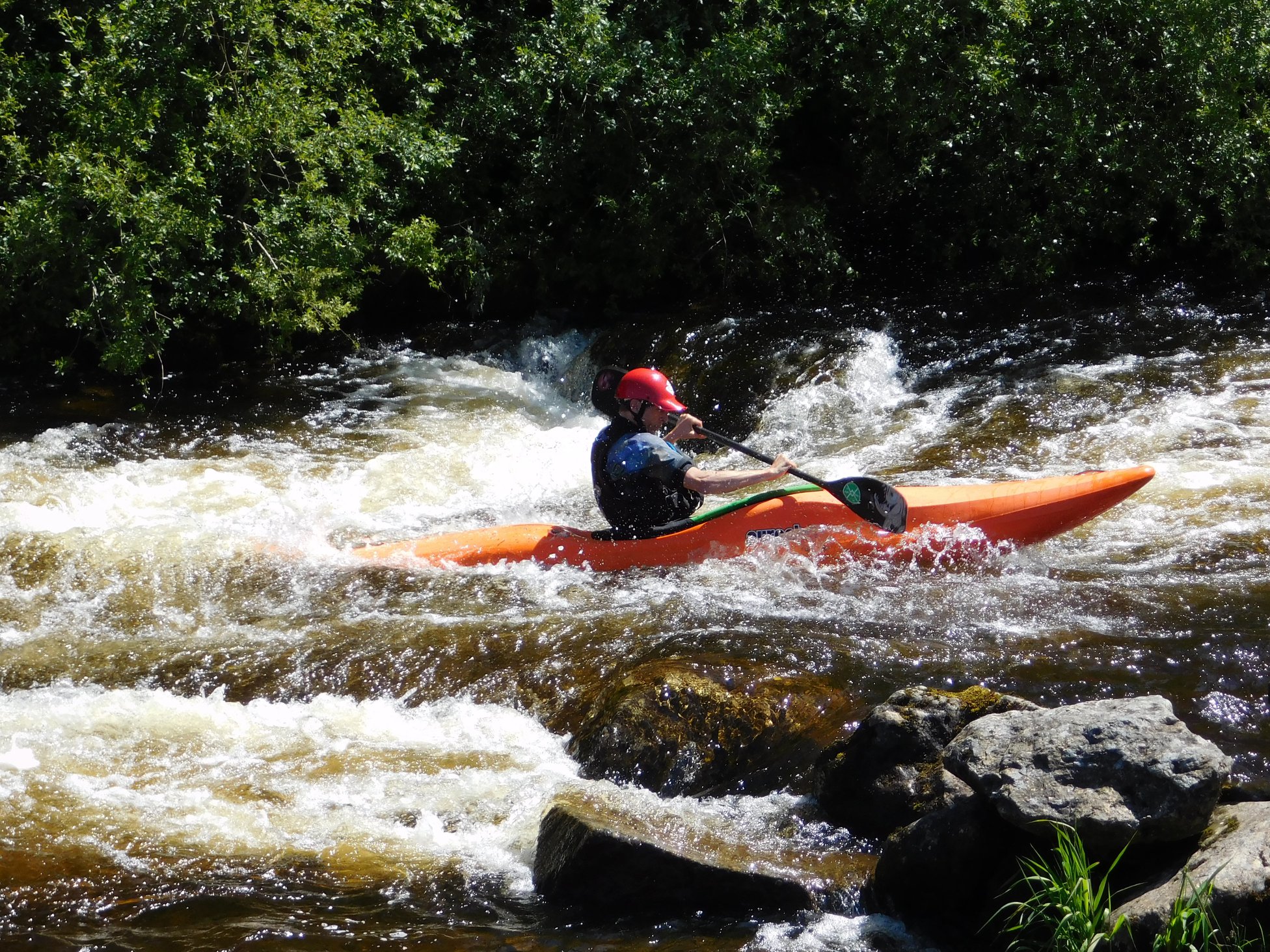
The 12R design team has included several athletes and coaches from Olympic Slalom, Wildwater and even Surf Ski. We’ve used that expertise to pay attention to how power is delivered through the boat to maximize forward speed; as a result of this unique approach to the paddler’s ergonomics, we have a narrow catch and outstanding cockpit geometry that has increased comfort and power delivery.
In short, we couldn’t be happier with what we’re feeling on the water. As 12R testing wraps up and final tweaks are made to maximize the design, we remain on track for a late Summer release.
29
Jun
The image below of our founder and MD, Graham Mackereth getting his first taste of driving a big rig from John Regan encapsulates the Pyranha family spirit perfectly, but there are few understated things about its three subjects that you might not know; allow us to explain…
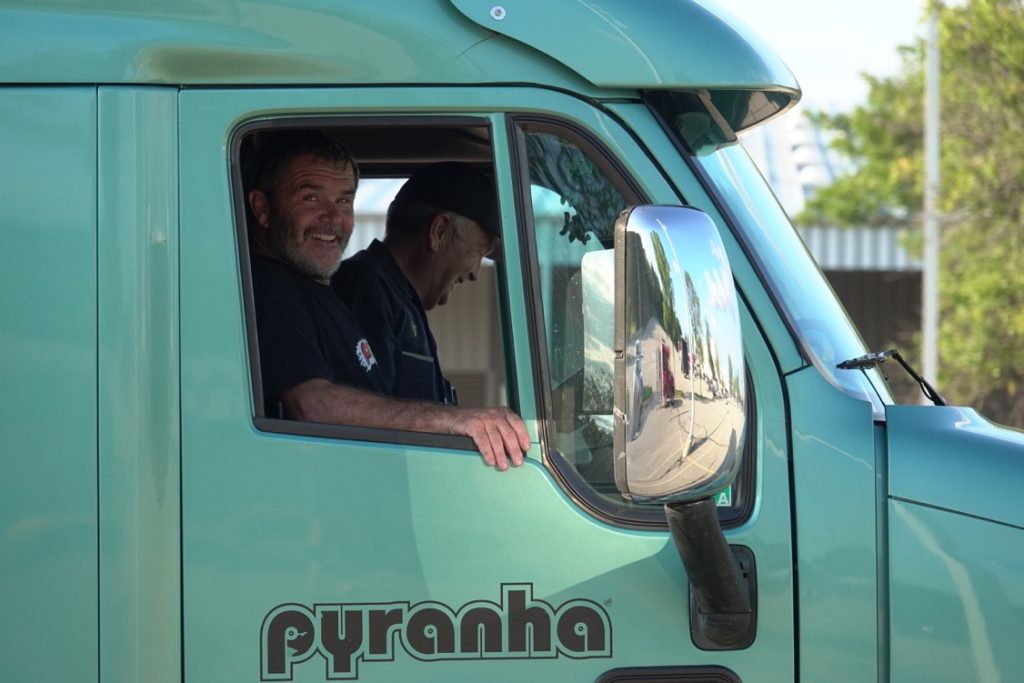
John Regan
Words alone aren’t enough to describe the man of legendary status named John Regan; chances are if you’re a kayaker in the US, you’ve met Regan, or at least heard him at some point! His voice is unmistakable and mirrors his personality exactly.
It’s also very likely that the 58-year-old logs more class 4-5 river days per year than most paddlers half his age; John makes his living as the Big-Rig truck driver for Pyranha, delivering kayaks all over the country, and because of this he’s kayaked in nearly every state, surfed waves up and down both coasts, and skied powder in every major mountain range. When not on the road he calls Friendsville, MD home, and the nearby Youghiogheny River wouldn’t be the same without him. He, along with other locals, helped pioneer many of the rivers in MD and WV and set the bar of what is considered a classic run. John’s energy and enthusiasm are hard to miss, he brings a level of stoke that is infectious and hilarious to be around. If given the chance to paddle with him, be prepared to feel humbled and tired from trying to keep up with his pace!! We at Pyranha are thankful to call him family.
Pete (the Big Green Truck)
Pete, as it’s commonly called, is the 2004 single axle Peterbilt that JR drives. The truck was ordered specifically by JR in his favorite color green, and with a single axle for hauling relatively “light” product like kayaks. The truck itself boasts JR’s name on the side, and the trailer has an 8ft tall Angry Fish on either side, making it hard to miss whether he’s driving down the highway or pulling into the dock at one of our dealers.
Graham Mackereth
Graham’s love of canoeing began at the age of 14 when a friend took him with his dad to launch a wood canvas PBK they had built together; he was instantly hooked and shortly after purchased a second-hand kayak with £11 he’d borrowed from his dad. This marked the beginning of an endless pursuit for a kayak faster than those of his friends, eventually leading to the purchase of what was the latest racing K1 at the time, a moulded veneer Struer Hunter, which cemented Graham’s admiration for the best in craftsmanship and technology and is a prized part of his collection to this day.
Finally giving in to requests from his friends to build them some River Racers, Graham set up shop in his Dad’s garage at the age of 21, and that’s where Pyranha began. Graham’s keen interest in the history of the sport as much as its future meant that whenever he came across another beautiful old canoe or kayak in need of a new home and some (or more often, rather a lot of) restoration, he couldn’t resist; as what we now affectionately refer to as Graham’s Museum grew, so did his knowledge of the crafts’ design and features.
This enthusiasm and affinity with boat design is the driving force behind the stream of innovations throughout Pyranha’s history; 1988’s Mountain Bat was the first kayak with a chine to reduce stern drag, inspired by a 1908 Sailing Canoe “Tritonelle”, a runaway winner so successful that she was banned; the Acrobat became the first planing kayak with hard rails in 1994, which was the next extension of the chine; and Pyranha was the first to make 3 sizes of WW kayak available with the InaZone, all done by Struer 20 years before so that paddlers in the Olympics had an even chance no matter how big or small. Many other lessons came from an almost forgotten past, unearthed by Graham’s passionate research.
Graham brought this family of enthusiasts together and is still actively involved in every aspect of the business today.
Pyranha: By Enthusiasts, For Enthusiasts
22
Jun
I absolutely love this trick, there is nothing more awesome than the feeling of sliding the tail of your kayak into the eddy line, feeling the power of the river engage on your tail, have the nose of your kayak fly up into the air and be spinning vertically down the river.
The Tailee requires a good amount of practice but it honestly isn’t that hard. Check out the steps below or click on the video link to learn how to do your first Tailee.
First things first, we have to find a spot where we can learn this trick. We are going to be looking for a nice deep, crisp powerful eddy line. Once you’ve found your ideal location it’s time to get vertical!
Step 1
Get some speed up, we are going to paddle from the back of the eddy towards the eddyline.
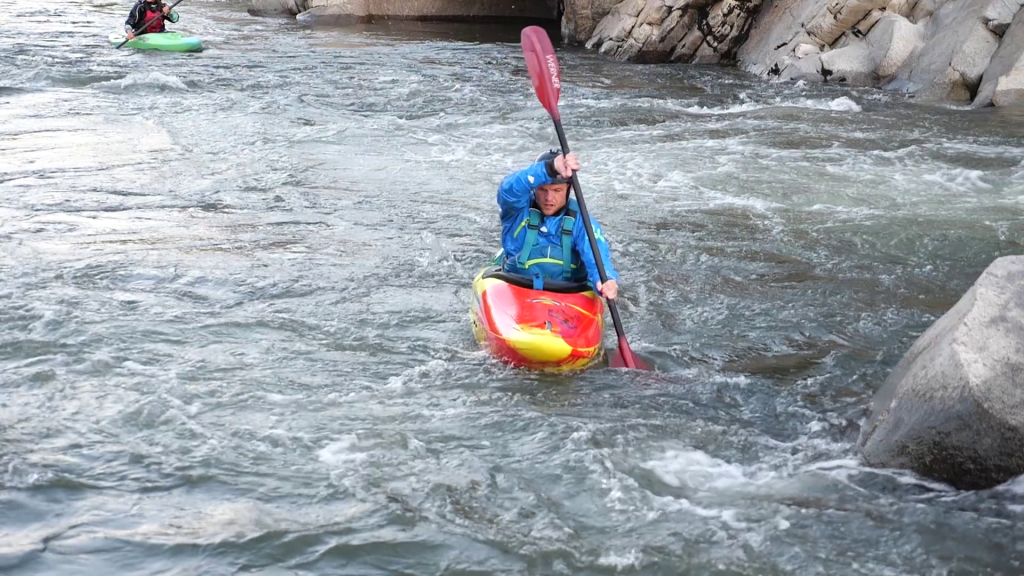
Step 2
Once the nose of your kayak is about to hit the eddyline, take a sweep stroke to encourage your kayak to spin downstream.
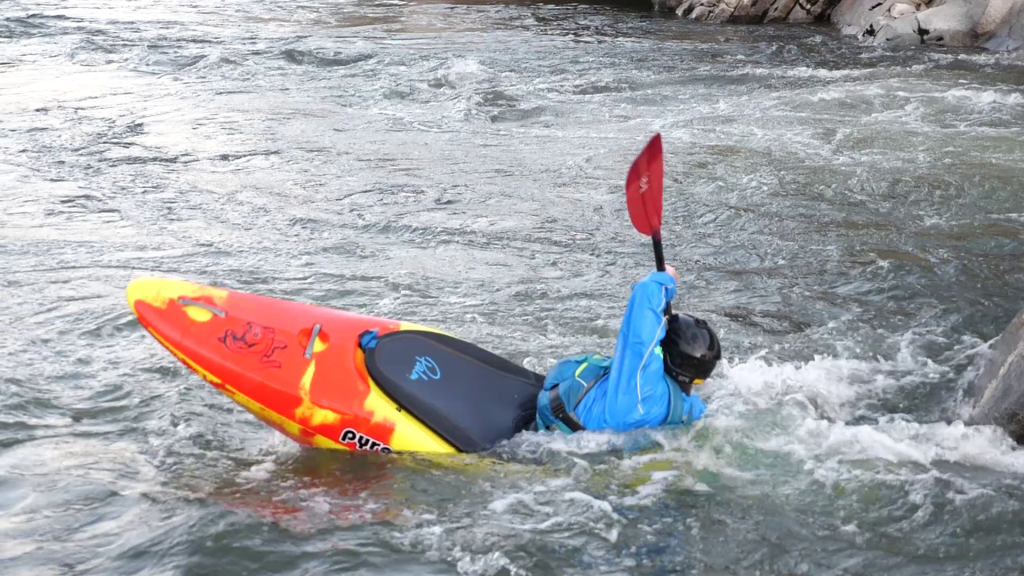
Step 3
Right as your hips are about to cross the eddyline drop your upstream edge (scary I know) and push really hard with the back of your paddle on the opposite side of your kayak and pull up hard on your knees.
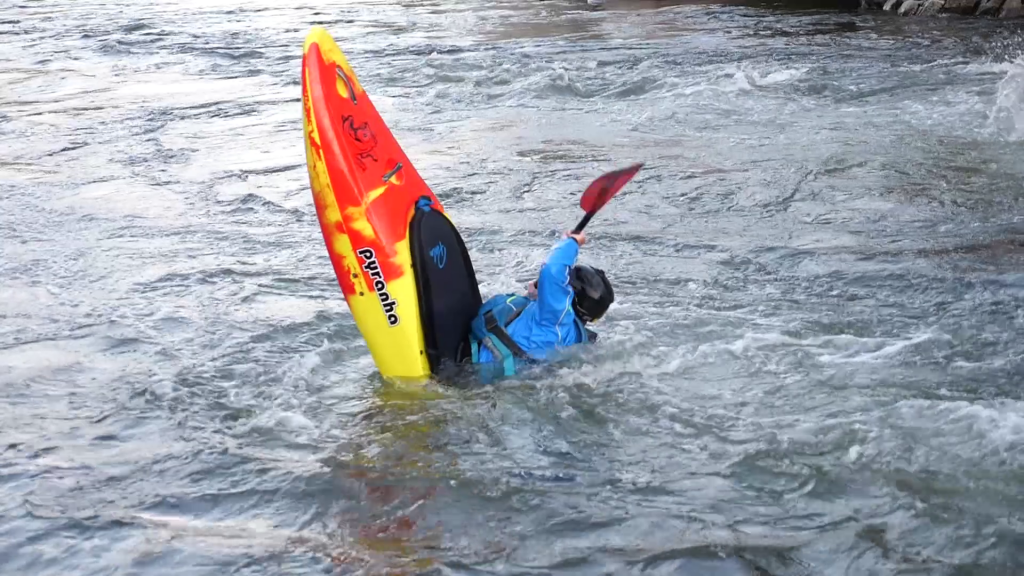
Step 4
Celebrate, if you did all of that correctly then you will be perfectly vertical, spinning downstream.
Check out the video tutorial for a more in-depth look at how to Tailee!
See you on the water,
Bren
21
Jun
While neither the 9R nor the Machno are new to the creek boating and river running scene, it wasn’t until just recently that I was able to use each of them extensively on various styles of whitewater. Overall, I would happily take either on any style of river run. They do have some fundamental differences and compliment each other exceptionally well. But, I realize that most of us can’t afford, nor do we really want a quiver of creek boats. So, here are my thoughts on the primary differences between these kayaks if you’re trying to decide which might better suit your needs. (For the record this comes from the bias of a medium-smallish paddler. I’m 5’7”, about 135 and realize that while I choose to paddle the 9R and Small Machno, this insight might not be as relevant to someone differently sized who might be choosing between a 9R and Machno)
SPEED- The 9R is known for its’ speed. Coming in at 8’6” instead of the 9R’s 8’11”, the Small Machno is not as fast as its’ sibling kayak. But, I was pleasantly surprised to find that it was not a slug and was actually quite quick compared to other creek boats. The 9R likes to handle everything with speed. If you’re not paddling aggressively, or are slowly approaching features trying to discern the line, the 9R will not perform as well. Conversely, while the Machno obviously performs better when paddled aggressively and with speed, it also handles unbelievably well when paddled casually, momentum has been lost, or when peeling out of an eddy directly into a boof. Both kayaks love rapidly skipping out after holes and boofs.
STABILITY – The desired and output speeds of the 9R and Machno feeds directly into their stability (which both are). The 9R’ss stability comes from being driven. The Machno, a bit wider and more comfortable with less speed, is naturally a bit more stable.
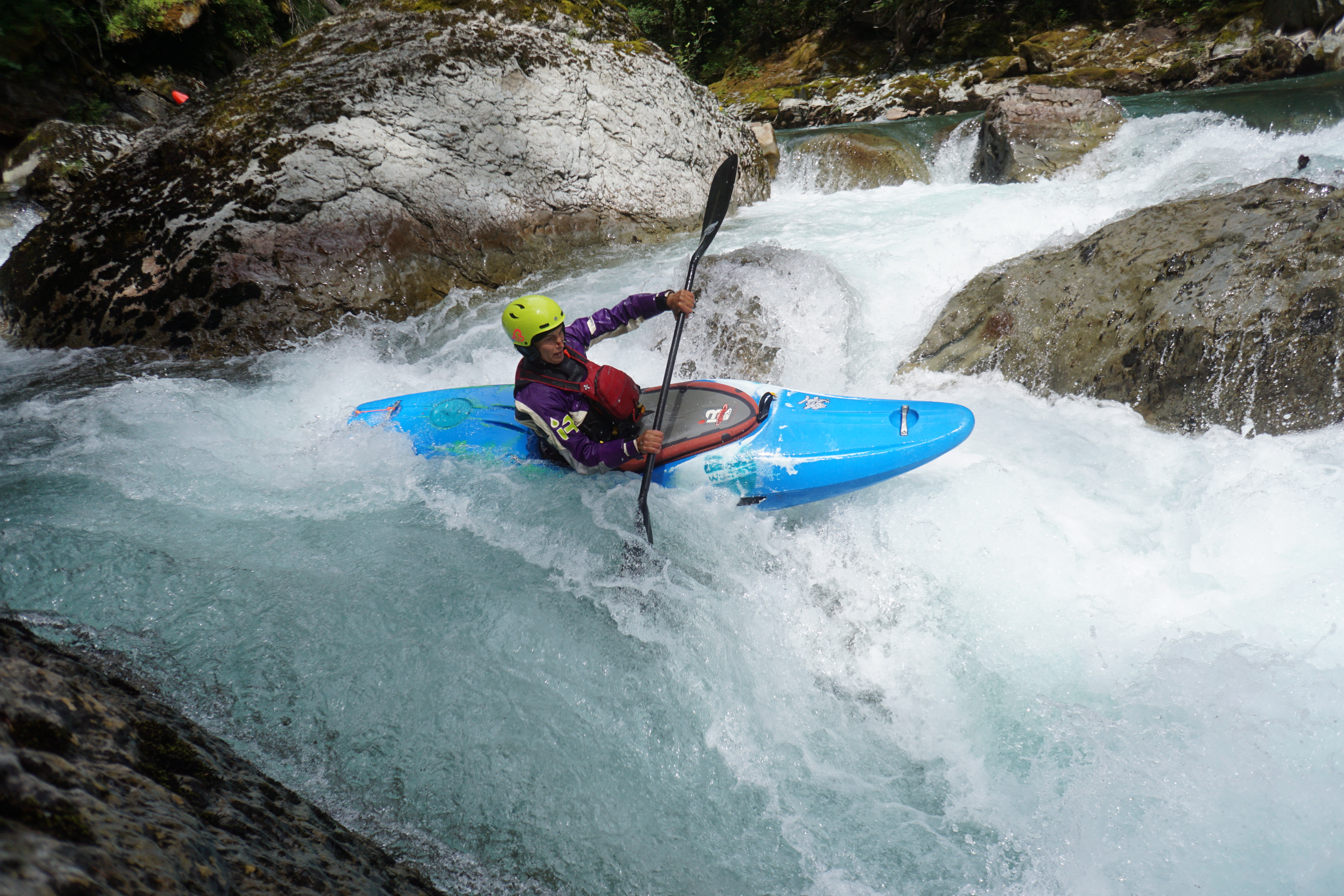
Jo Kemper Cruising her 9r amongst the rocks, holes, and siphons on the Ohanepecosh (Photo Nouria Newman)
EDGE – Both boats feature a non-aggressive edge, which is nice for holding a line and peeling in and out of eddies. The 9R’s edge is a bit more prevalent than the Machno. This edge combined with its’ narrowness and speed makes carving, eddy catching, and s-turns in the 9R super fun, even in chiller whitewater. Although they have edges, they’re certainly not box-y and the hulls of both are rounded creating seamless edge to edge transitions and a bit of forgiveness with flat landings. While carving around in the 9R is more enjoyable, the Machno is more fun sliding down or around rocky features.
TURNABILITY – The 9R and Machno both hold lines really well. The Machno turns easier than the 9R. Depending on the situation, you might be craving either.
BOOFABILITY – Bottom line, they both boof exceptionally well. They’re easy to boof, forgiving, and enjoy ripple skipping out of the bottom of drops. While the 9R likes to take drops straight on, owing to its’ easy to turn nature, the Machno is super fun to sweep boof. Approaching a drop not quite straight on, but being able to skip out straight from the bottom is both a fun and forgiving feature of the Machno. Similarly, they both plug. Tall waterfalls and steep creeks, my vote is for the Machno, (but the 9R also gets the job done remarkably well).
OVERNIGHTERS- While I’ve taking the 9R on many overnight trips and like it immensely, speed and stability come a bit more into play. I notice that I really need to get it up to speed for it to perform well. For big water river running and creeking, I’ve been stoked. On tighter creeks I’ve been a little less so. The Machno loves overnighters. For the shorter paddler, it’s a bit more pleasant to carry the Machno using a backpack portage system or while negotiating around rocks.
Overall, like I said before, I am stoked to paddle either the 9R or Machno on all types of whitewater, whether it be big water river running or creeking, cruising down your backyard run, low volume steep creeking, or exploratory overnighters. The 9R is your Ferrari, the Machno is your Hummer. (The analogy might not be perfect) The decision is a matter of preference, your style, and what type of whitewater you find yourself mostly paddling. I like the nimble playfulness and stability of the Machno on steep creeks, low volume whitewater, and overnighters. I enjoy the speed and carvibility of the 9R on river runs, higher volume creeking, and making easier whitewater dynamic and fun.
06
Jun
When the concept of the Ripper started being discussed I was immediately very excited.
A boat that paddled like a slalom boat, played like an old school playboat, and ran rivers like a creek boat. The key features had to add up to a boat that you could not only spend hours doing tailies looking at the sky, but also paddle some serious whitewater with your mates.
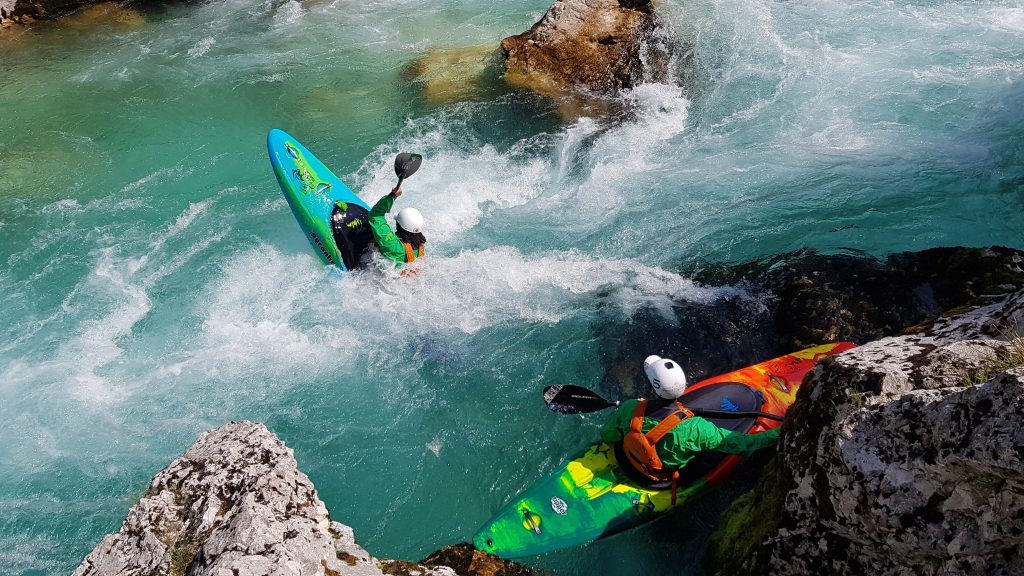
Chris Brain & Tom Parker Ripping Up the Soca, by Paul Smith
Several months have now gone by, and after spending many hours, days, and weeks paddling the Ripper M and S (an L size is also available), I feel that I have a pretty good idea of what this boat really means to me, and where it sits in the Pyranha lineup.
The Ripper is an iconic change. We saw this with the 9R in 2014, bringing a boat that was significantly faster and longer than other creek boats in the market, and with the Ripper, it is much the same. This boat combines speed with immense amounts of fun, in a very different way to the other “squashed tail” boats which are available.
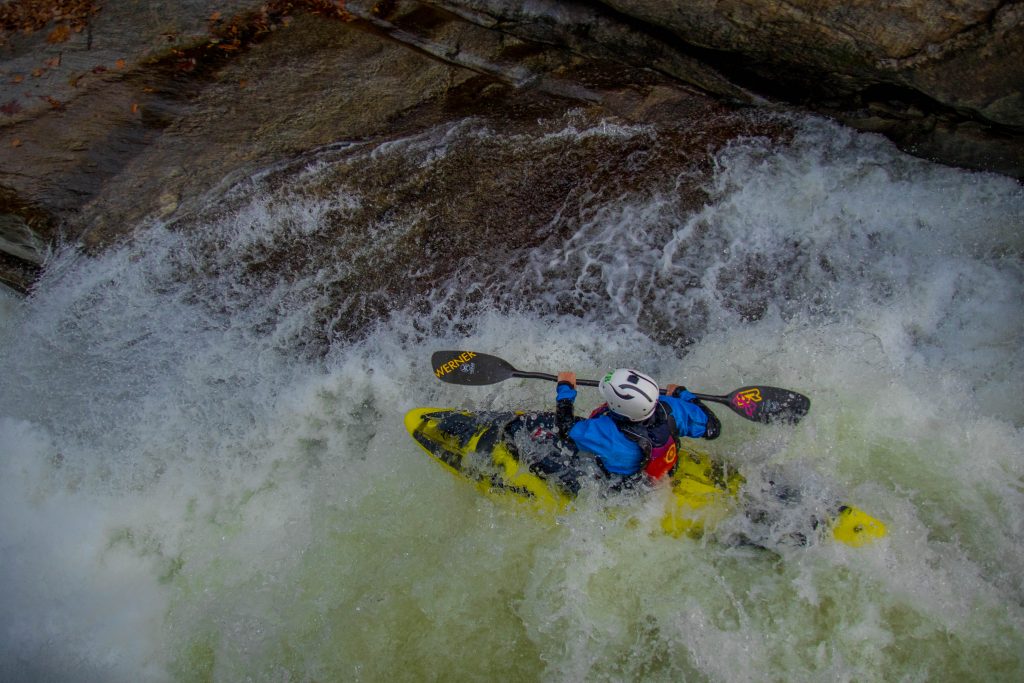
Ty Caldwell Letting Rip on Gorilla, by Dave Deggendorf
The main thing I like about the Ripper is its unique volume distribution combined with the width of the boat; this neat combination allows super fast edge transitions in a boat that still looks after you. Playing all day has never been more enjoyable.
The planing hull also allows the boat to surf almost every wave on the river, being fast enough to catch even the flattest ones whilst your mates can only watch from the eddy. The bow rocker has helped with that, balancing the need to be fast with the importance of handling and boofing.
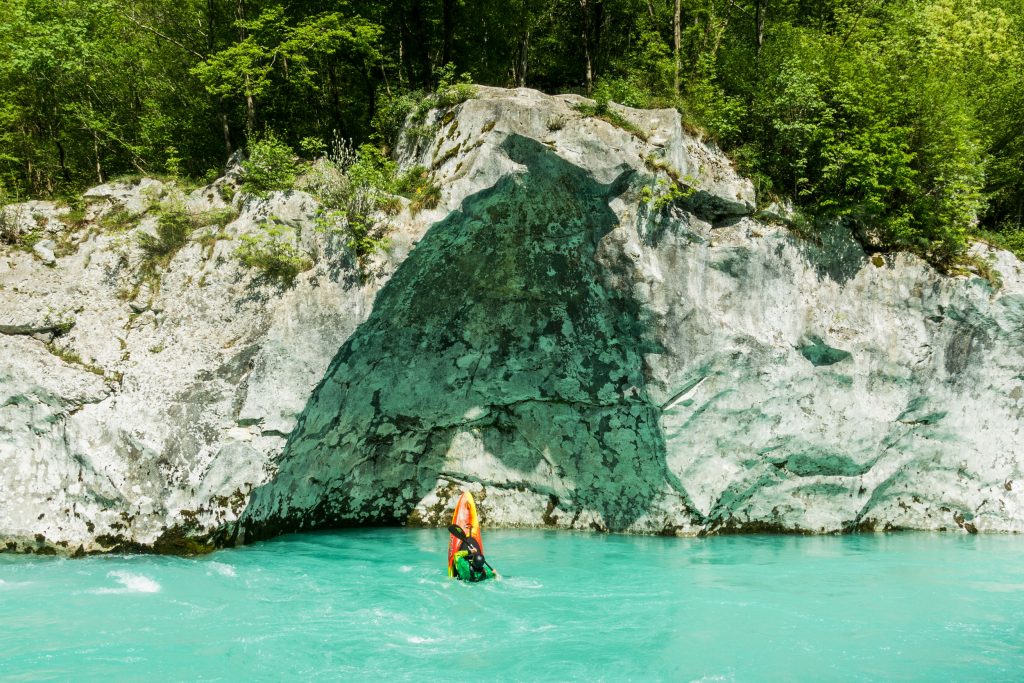
David Bain Getting Recklessly Vertical on the Soca, by Tom Rainey
The Ripper is a massive change for most people paddling bigger creek boats, but try this boat out and you will see why the hype is justified; it will leave you with a smile ear to ear and help you become a better kayaker as a result.